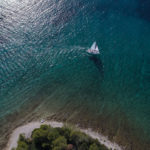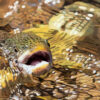Mark Kurlansky is a New York Times bestselling and James A. Beard Award-winning author whose recent book, “Salmon: A Fish, the Earth and the History of Their Common Fate” (Patagonia, March 2020), focuses on the saga and plight of one of nature’s greatest fish. He has published more than 30 books over a long and storied career, including “Cod,” “Salt: A World History,” “The Big Oyster,” “1968,” “Milk!: A 10,000-Year Food Fracas” and “The Unreasonable Virtue of Fly Fishing.”

Kurlansky is known for his attention to detail, thorough research and unique multi-century storytelling. “Salmon” is a work that lives up to his reputation. Attractive enough to reside on your coffee table but small enough to fit on a shelf, the book’s 448 pages are filled with more than 150 photographs and illustrations that provide additional insight into the chronicle of these fish and their interaction with man.
An angler himself, Kurlansky writes with passion about the struggles that salmon face in nature and at the whim of humans. These fish encounter many of the same environmental challenges as people, such as the ravage of climate change, yet are victim to significant pressures caused by over-fishing, dams constructed in their spawning rivers, contamination from hatcheries, fish farms and industrial pollution. Humans have introduced these ongoing insults to their reality. If we don’t take measures to reverse the harm, these pressures may ultimately lead to their demise. And no one understands this precarious situation better than Kurlansky.
“Salmon travel,” he writes. “A king salmon will swim for four years at sea and travel some ten thousand miles. At sea, salmon contend not only with the many predators, but also with storms, occasional lack of food, unpredictable climate shifts, and sometimes pollution. But it is in returning to the river that they undertake their most extraordinary journey, one from which they cannot be deterred even though in the end it leads to death.”
With their connection to fresh and salt water, and their reliance on marine and terrestrial ecology, salmon are in a unique position as a proxy to measure the health of our planet. They are a true indicator species, and their plight has significant implications.
Kurlansky offers a wake-up call as he describes the scope of the problem we are facing. “How many species do we lose when we lose a salmon?” he writes. “And how many others do we lose from losing those?”

The author’s concerns are substantial and worthy of notice. One of Kurlansky’s colleagues, and the man to whom he dedicated this important work, is the late Icelandic conservationist Orri Vigfusson. Known for his business-like approach to preservation, Vigfusson was one of salmon’s greatest allies who created new and innovative solutions. Notably, he focused on buying fishing rights from commercial fishermen, thereby saving millions of endangered North Atlantic salmon. His efforts also prompted other important conversations about finding new ways to help these fish survive.
While the labors of those fighting for salmon are heroic and necessary, Kurlansky’s call is more serious. Climate change is real and calls for comprehensive and substantial action. His observations and ultimate warning in the book are ominous.

Pink salmon swimming up Lawson Creek to spawn under the northern lights.Photo by Christopher Miller
“Humanity’s grasp on the planet is not strong. It is growing weaker. Our population is too large for safety and comfort.”
In these pages, Kurlansky puts us on notice. The time to act is now. While Vigfusson and others have taken steps to help protect salmon, more work needs to be done.
Kurlansky’s plea is simple and direct: “If salmon don’t survive, there is little hope for the survival of the planet.”
Learn more and buy the book at Patagonia.com/shop/books.
Eric Kallen is Editor-at-large of The Virginia Sportsman
Cover photo: Coho fry soon after emerging from the gravel in the Quinsam River, British Columbia / Photo by Eiko Jones


















